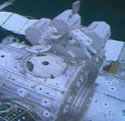
Image credit: NASA
Astronauts Donald Pettit and Kenneth Bowersox enjoyed their first ever walk in space on Wednesday as they performed some maintenance work on the International Space Station. The walk was slightly delayed because of a sticky hatch, but after about 20 minutes they made it outside the station. They spent a total of 6 hours and 51 minutes outside the station.
Expedition 6 Commander Ken Bowersox and NASA Science Officer Don Pettit continued the assembly of the International Space Station today and set the stage for a series of complex shuttle construction flights to the complex later this year during a 6-hour, 51-minute spacewalk staged out of the Quest Airlock.
The spacewalk, which was the first for both Bowersox and Pettit, was the 50th excursion in support of the assembly and maintenance of the ISS, the 25th originated from the Station itself and the 16th conducted from Quest. Russian cosmonaut Nikolai Budarin supported the spacewalk from inside the ISS, acting as the spacewalk choreographer while operating television cameras on the Canadarm2 robotic arm.
After encountering some difficulty opening the airlock hatch due to a strap on the inside of the thermal hatch cover, the hatch finally swung open and Bowersox and Pettit began their spacewalk at 6:50 a.m. Central time by placing their suits on internal battery power. As he did, Bowersox reported a loss of digital data for his suit systems, requiring him to recycle his suit power that cleared up the momentary glitch. Once outside, Bowersox and Pettit quickly set up tools and gear, then moved to the recently installed Port One (P1) Truss segment, where they released ten remaining launch restraints from the truss? radiator system. Eight others had been released when the truss was delivered to the ISS last November on the STS-113 mission.
Flight controllers then sent commands to unfurl the P1?s center radiator, enabling it to extend to its fully deployed length of 75 feet, preparing the system for its activation later this year to provide cooling for station systems. The deployment took only 9 minutes to complete.
After inspecting some hardware on the P1 Truss for engineers on the ground, the two spacewalkers made their way to the Unity connecting node, where Pettit used Kapton tape to dab away small amounts of grit from a sealing ring on the nadir Common Berthing Mechanism, leaving the CBM in a pristine condition for the attachment of the Raffaello Multi-Purpose Logistics Module during the next shuttle flight to the station in March.
Bowersox and Pettit were unable to complete one minor task, the installation of a stanchion and a light fixture on one of two handcarts located on the Starboard One (S1) Truss which future spacewalkers will use to transport themselves up and down the station?s truss system. The stanchion would not release from its stowed position on the truss, apparently because of a pin interfering with its movement, and the task, considered a low priority for today?s spacewalk, was deferred to a future Expedition excursion.
As they neared the end of their spacewalk, Bowersox and Pettit returned to the center of the station, as Pettit retrieved tools from a storage box on the Z1 Truss and conducted a health check on an ammonia reservoir that was delivered to the P6 solar array truss structure in 2001. That ammonia system will be used to partially fill the cooling loops of the P1 Truss on an intricate shuttle assembly flight later this year that will occur in the midst of the reconfiguration of station power systems.
As they reentered the Quest Airlock, Bowersox and Pettit used a scissors to cut away the strap on the hatch cover which interfered with the rotation of the hatch handle at the start of the spacewalk. The hatch closed normally with no further problems expected in the future.
With their work completed, Bowersox and Pettit completed their spacewalk at 1:41p.m. Central time, raising the total spacewalk time for ISS assembly and maintenance to 312 hours and 11 minutes.
Before the spacewalk began, robotic engineers in Mission Control sent commands to move the station?s Mobile Transporter from the far end of the P1 Truss to its normal parking place at the centermost S0 Truss segment to protect its umbilical cable from any potential damage from orbital debris. The Transporter began its move from the P1 Truss to the S0 Truss at 1:53 a.m. Central time, latching itself in place about 20 minutes later.
The transporter is used to maneuver the Canadarm2 space crane up and down the length of the station?s trusses for assembly work. It had been parked on the P1 Truss during the STS-113 mission when it ran into a communication antenna on the truss, delaying its use for one of that flight?s spacewalks. Today, it moved back to its normal parking place uneventfully.
Bowersox, Budarin and Pettit will enjoy an off-duty day Thursday in the wake of today?s spacewalk before resuming their normal complement of scientific experiments and ISS housekeeping on Friday.
Original Source: NASA News Release
